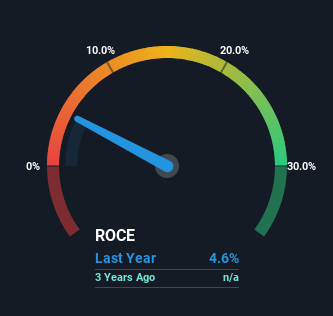- South Korea
- /
- Auto Components
- /
- KOSDAQ:A437730
Be Wary Of Samhyun (KOSDAQ:437730) And Its Returns On Capital
If we want to find a stock that could multiply over the long term, what are the underlying trends we should look for? In a perfect world, we'd like to see a company investing more capital into its business and ideally the returns earned from that capital are also increasing. This shows us that it's a compounding machine, able to continually reinvest its earnings back into the business and generate higher returns. In light of that, when we looked at Samhyun (KOSDAQ:437730) and its ROCE trend, we weren't exactly thrilled.
Our free stock report includes 2 warning signs investors should be aware of before investing in Samhyun. Read for free now.Understanding Return On Capital Employed (ROCE)
Just to clarify if you're unsure, ROCE is a metric for evaluating how much pre-tax income (in percentage terms) a company earns on the capital invested in its business. The formula for this calculation on Samhyun is:
Return on Capital Employed = Earnings Before Interest and Tax (EBIT) ÷ (Total Assets - Current Liabilities)
0.046 = ₩5.5b ÷ (₩140b - ₩21b) (Based on the trailing twelve months to December 2024).
Thus, Samhyun has an ROCE of 4.6%. In absolute terms, that's a low return and it also under-performs the Auto Components industry average of 7.5%.
Check out our latest analysis for Samhyun

Historical performance is a great place to start when researching a stock so above you can see the gauge for Samhyun's ROCE against it's prior returns. If you'd like to look at how Samhyun has performed in the past in other metrics, you can view this free graph of Samhyun's past earnings, revenue and cash flow.
How Are Returns Trending?
When we looked at the ROCE trend at Samhyun, we didn't gain much confidence. Over the last one year, returns on capital have decreased to 4.6% from 19% one year ago. Meanwhile, the business is utilizing more capital but this hasn't moved the needle much in terms of sales in the past 12 months, so this could reflect longer term investments. It's worth keeping an eye on the company's earnings from here on to see if these investments do end up contributing to the bottom line.
On a related note, Samhyun has decreased its current liabilities to 15% of total assets. So we could link some of this to the decrease in ROCE. What's more, this can reduce some aspects of risk to the business because now the company's suppliers or short-term creditors are funding less of its operations. Some would claim this reduces the business' efficiency at generating ROCE since it is now funding more of the operations with its own money.
The Key Takeaway
Bringing it all together, while we're somewhat encouraged by Samhyun's reinvestment in its own business, we're aware that returns are shrinking. Since the stock has gained an impressive 36% over the last year, investors must think there's better things to come. Ultimately, if the underlying trends persist, we wouldn't hold our breath on it being a multi-bagger going forward.
If you want to know some of the risks facing Samhyun we've found 2 warning signs (1 is a bit unpleasant!) that you should be aware of before investing here.
While Samhyun may not currently earn the highest returns, we've compiled a list of companies that currently earn more than 25% return on equity. Check out this free list here.
New: Manage All Your Stock Portfolios in One Place
We've created the ultimate portfolio companion for stock investors, and it's free.
• Connect an unlimited number of Portfolios and see your total in one currency
• Be alerted to new Warning Signs or Risks via email or mobile
• Track the Fair Value of your stocks
Have feedback on this article? Concerned about the content? Get in touch with us directly. Alternatively, email editorial-team (at) simplywallst.com.
This article by Simply Wall St is general in nature. We provide commentary based on historical data and analyst forecasts only using an unbiased methodology and our articles are not intended to be financial advice. It does not constitute a recommendation to buy or sell any stock, and does not take account of your objectives, or your financial situation. We aim to bring you long-term focused analysis driven by fundamental data. Note that our analysis may not factor in the latest price-sensitive company announcements or qualitative material. Simply Wall St has no position in any stocks mentioned.
About KOSDAQ:A437730
Samhyun
Engages in the manufacture and sale of parts and accessories for motor vehicles.
Excellent balance sheet with low risk.
Market Insights
Community Narratives



